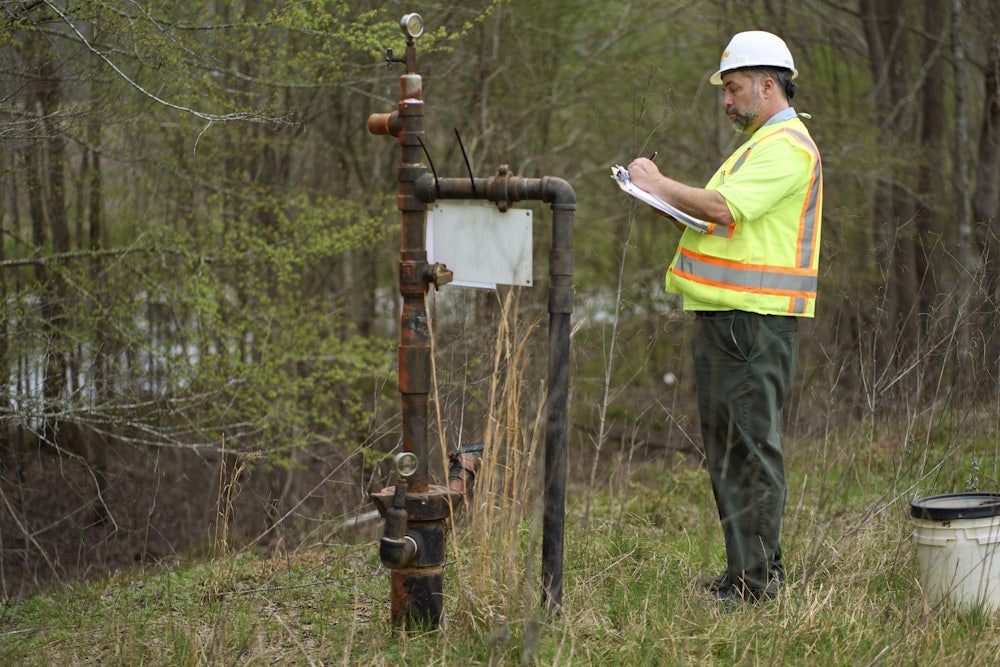At first glance, the story of First Republic Bank wouldn’t seem to have much to do with the fossil fuel industry. The former was just seized by regulators after becoming the third U.S. lender to fail since March, and sold off to JP Morgan Chase. The latter has experienced record profits both last year and in the first quarter of 2023, so much so that two of its leading lights—ExxonMobil and Chevron—now face a novel problem: how to spend too much cash. With tens of billions of dollars on hand, both companies are poised to snap up smaller and more beleaguered drillers over the coming years. They’ll keep what of their assets are profitable and spit out the rest.
In both cases, massive, thriving players are acquiring smaller and considerably more troubled firms. In First Republic’s case, however, the government is orchestrating the purchase as a way of limiting the fallout from First Republic’s failure. While crises faced by struggling drillers are less acute than the bank’s, their collapse poses a number of problems—some financial, some environmental—with no analogous safety net. The public will have to pay the sizable costs of cleaning up their mess or deal with the effects of no cleanup at all.
Despite the long history of closure and consolidation in the fossil fuel industry, that massively important sector—the chief driver of climate change—lacks the kind of state-supervised process that exists for banks. The FDIC’s Deposit Insurance Fund spent $13 billion to sell First Republic to JP Morgan on the premise that it is bad for banks to fail and leave their customers hanging. That money comes from banks themselves, who pay into the fund so that they can absorb the risks of some banks so that they don’t spread to the rest of the sector and into the larger economy. As shale drillers continue to face dim prospects moving forward—reckoning with investor demands and declining production—there’s no equivalent to wind them down in the public interest.
What happens when a fossil fuel company fails or wants to get rid of assets that aren’t profitable anymore? Before it goes bankrupt it might get bought up by a bigger company. ExxonMobil, for instance, is now reportedly looking to spend its extra cash on Pioneer Natural Resources. Industry watchers see this as heralding a new wave of consolidation over the coming decades. But players like Exxon and Chevron will only keep assets that they can reasonably expect to produce profits from, selling off the rest to the highest bidder. That’s when things get weird. The little-known firm Diversified Energy, for instance, has become the country’s largest owner of wells in the country by buying them up for cheap as they start to run dry, keeping them on life support for decades to continue to pay out dividends to shareholders.
There’s nothing unusual about one company acquiring another, less prosperous one or its assets. When it comes to oil and gas production, though, there are major downsides to letting the industry decide how major changes within the sector are handled. The Environmental Defense Fund has found that there are 120,000 known “orphan” oil wells spread out around the country. While no longer productive economically, many continue to pour greenhouse gases into the atmosphere and pollute air and water locally with substances like arsenic and benzene; there are no surviving records of who owns them. EDF researchers note that “estimates of additional undocumented orphan wells range from the many hundreds of thousands to several million in the U.S. alone.” The bipartisan infrastructure law furnished $4.7 billion for states to plug them after the Department of Interior released $1.15 billion. So-called bonding rules are meant to require that drillers pay states and the federal government to clean up unused wells. But most of these schemes haven’t been updated in decades and remain grossly underfunded. Pennsylvania, in fact—home to more than 18,000 orphan wells—passed a 10-year ban on raising bonding requirements on wells drilled after 1985; those drilled before, which account for the majority of orphan wells, don’t require any bonding at all.
This problem could soon get a lot bigger thanks to shifts in the fossil fuel industry. Giants like Exxon and Chevron have dutifully paid down debts incurred over a decade of bad performance and then the Covid-19 pandemic, when quarantine measures reduced demand for oil and gas. As travel was starting to recover, Vladimir Putin decided to invade Ukraine. In response, Western governments sought to wean themselves off Russian fossil fuels to avoid inadvertently supporting the Russian war effort and not face dire shortages if Putin cut them off. Non-Russian fossil fuel companies subsequently raked in both record profits and the reputational rewards of having saved Europe. The trend of ExxonMobil’s and Chevron’s record earnings last year has continued. The former announced record first-quarter results last week of $11.4 billion. Net profits at Chevron are up 5 percent over Q1 2022.
Instead of chasing high prices with the kind of production binges that defined the shale boom, Exxon and Chevron have paid out generously to shareholders and top managers (ExxonMobil CEO Darren Woods got a 52 percent pay bump last year) and been more conservative on new exploration and production than a White House laser-focused on low gas prices would have liked. Smaller companies, meanwhile, face a radically different business model in the shale patch. Even those that have survived and cleaned up their balance sheets see reasons to worry: Productivity gains have ground to a halt, and costs for labor and materials are rising along with interest rates. The prospects for the shale businesses in the long run are grim. Bloomberg’s Javier Blas reported recently that U.S. oil and gas production is expected to peak in the next three to five years. Shale formations that were important in the first wave of the boom, including the Bakken and Eagle Ford deposits, already have.
Absent an overhaul in how leaky old wells are handled, a new wave of mergers and acquisitions in the fossil fuel industry is very likely to add to the pile of toxic waste being siphoned off to private equity vultures or little-known companies like Diversified. Others will pay the price of the industry’s leaner, more profitable operations: communities saddled with benzene fountains; states picking up the tab for plugging abandoned wells, albeit now with some help from the government; and the planet poisoned by assets either juiced for all they’re worth or left to leak indefinitely. The U.S. has decided that its banks are too big to fail. As the climate crisis mounts, policymakers should also realize that fossil fuel companies are too dangerous to be able to dictate the terms of their own failure.










